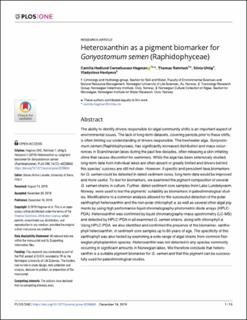| dc.contributor.author | Hagman, Camilla Hedlund Corneliussen | |
| dc.contributor.author | Rohrlack, Thomas | |
| dc.contributor.author | Uhlig, Silvio | |
| dc.contributor.author | Hostyeva, Vladyslava | |
| dc.date.accessioned | 2020-11-09T07:08:42Z | |
| dc.date.available | 2020-11-09T07:08:42Z | |
| dc.date.created | 2020-01-08T13:11:45Z | |
| dc.date.issued | 2019 | |
| dc.identifier.citation | PLOS ONE. 2019, 14 (12), . | en_US |
| dc.identifier.issn | 1932-6203 | |
| dc.identifier.uri | https://hdl.handle.net/11250/2686841 | |
| dc.description.abstract | The ability to identify drivers responsible for algal community shifts is an important aspect of environmental issues. The lack of long-term datasets, covering periods prior to these shifts, is often limiting our understanding of drivers responsible. The freshwater alga, Gonyostomum semen (Raphidophyceae), has significantly increased distribution and mass occurrences in Scandinavian lakes during the past few decades, often releasing a skin irritating slime that causes discomfort for swimmers. While the alga has been extensively studied, long-term data from individual lakes are often absent or greatly limited and drivers behind this species’ success are still not clear. However, if specific and persistent taxa biomarkers for G. semen could be detected in dated sediment cores, long-term data would be improved and more useful. To test for biomarkers, we examined the pigment composition of several G. semen strains in culture. Further, dated sediment core samples from Lake Lundebyvann, Norway, were used to test the pigments’ suitability as biomarkers in paleolimnological studies. Modifications to a common analysis allowed for the successful detection of the polar xanthophyll heteroxanthin and the non-polar chlorophyll a, as well as several other algal pigments by using high performance liquid chromatography-photometric diode arrays (HPLC-PDA). Heteroxanthin was confirmed by liquid chromatography-mass spectrometry (LC-MS) and detected by HPLC-PDA in all examined G. semen strains, along with chlorophyll a. Using HPLC-PDA, we also identified and confirmed the presence of the biomarker, xanthophyll heteroxanthin, in sediment core samples up to 60 years of age. The specificity of this xanthophyll was also tested by examining a wide range of algal strains from common Norwegian phytoplankton species. Heteroxanthin was not detected in any species commonly occurring in significant amounts in Norwegian lakes. We therefore conclude that heteroxanthin is a suitable pigment biomarker for G. semen and that this pigment can be successfully used for paleolimnological studies. | en_US |
| dc.language.iso | eng | en_US |
| dc.rights | Navngivelse 4.0 Internasjonal | * |
| dc.rights.uri | http://creativecommons.org/licenses/by/4.0/deed.no | * |
| dc.title | Heteroxanthin as a pigment biomarker for Gonyostomum semen (Raphidophyceae) | en_US |
| dc.title.alternative | Heteroxanthin as a pigment biomarker for <i>Gonyostomum semen</i> (Raphidophyceae) | en_US |
| dc.type | Peer reviewed | en_US |
| dc.type | Journal article | en_US |
| dc.description.version | publishedVersion | en_US |
| dc.source.pagenumber | 15 | en_US |
| dc.source.volume | 14 | en_US |
| dc.source.journal | PLOS ONE | en_US |
| dc.source.issue | 12 | en_US |
| dc.identifier.doi | 10.1371/journal.pone.0226650 | |
| dc.identifier.cristin | 1768555 | |
| cristin.ispublished | true | |
| cristin.fulltext | original | |
| cristin.qualitycode | 1 | |

